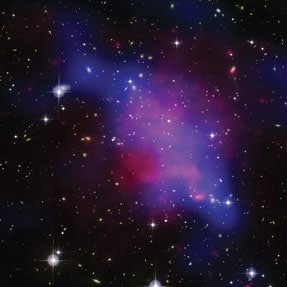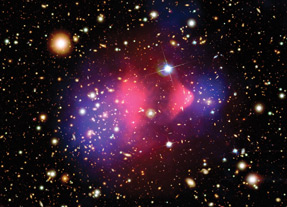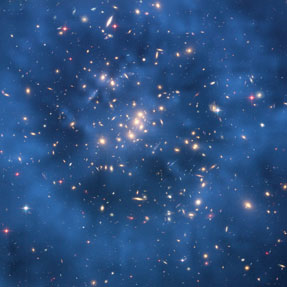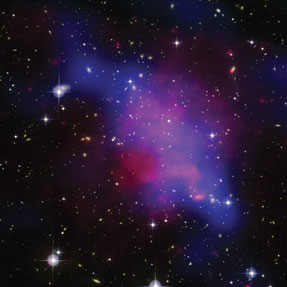Life
A Light on Dark Matter

What we see comprises just 10 percent of our universe. We know nothing of the remaining 90 percent, except that it exercises gravitational pull on observable objects.
| Inside an old iron mine in northern Minnesota, an array of cryogenic detectors are attempting patiently to capture the fingerprints of dark matter, which makes up 90% of the entire matter in the universe. In December, they reported a possible whiff of dark matter. If dark matter truly exists it would rewrite our cosmic ancestry.
Elementary particles, such as protons and neutrons, comprise our visible universe. Anything from stars to planets to single cell organisms, are all the product of these particles, which are known as baryonic matter. We are tempted to think that the whole universe is filled with baryonic matter in different forms— humans, animals, planets, stars and galaxies. But cosmic researchers believe that this type of matter accounts for only a small fraction of all matter in the universe — just 10 percent. The detection of this ordinary form of matter, as we know it, is possible through electromagnetic radiations ranging from gamma rays to radio waves. On the other hand, the presence of dark matter, which is assumed to comprise 90 percent of the universe, is known only through the gravitational forces it exerts on other objects.
David Law, astrophysicist at the University of California, Los Angeles, says: “While we may not be able to see the dark matter, it’s a vitally important component of our galaxy. It makes up the bulk of what the actual stuff is in our galaxy.” Scientists believe that dark matter is made up of non-baryonic exotic particles, such as WIMPS, or Weakly Interacting Massive Particles. The interaction of WIMPS with ordinary matter is a delicate phenomenon. Sporadically these particles scatter from the normal atoms. Under ideal conditions, such scattering can be spotted as it produces detectable traces of energy. That’s what the scientists are attempting in Minnesota’s Soudan Underground Mine, which houses the Cryogenic Dark Matter Search (CDMS) experiment, some 800 meters underground. The supporting evidences for dark matter comes from the study of galaxies and clusters. In our own Milky Way galaxy about 200 billion stars orbit around the center of the galaxy. Under the laws of gravitation, the pull on the outer stars should be weaker than on the inner ones and thus they should be moving slowly near the spiral edges. But the observational data shows that even these stars are orbiting at high velocities. This implies that there has to be lot more mass in the galaxy than we can see. This anomaly has been observed in every galaxy astronomers have identified. This undetectable mass that fills the galaxies or clusters shapes the motion of individual stars and galaxies through its invisible hands.
A galaxy cluster contains several galaxies and by observing their motion, it is possible to deduce the mass of the cluster using the laws of gravity. This is similar to determining the mass of the sun — the center of the solar system — by knowing the velocity and distance of the planets from the sun. Now, the laws of gravity must be equally valid in the realm of planets, stars or galaxies. The measured velocities of the galaxies indicate that there must be much more mass in the cluster than the visible matter. That’s where dark matter emerges — an offshoot of the laws of gravity. Even with modern day observations, this discrepancy between the visible matter and the observed motion remains. Another evidence for the existence of dark matter is found through gravitational lensing. Much like a lens bends light rays, galaxy clusters bend the light from background galaxies. The distorted galaxy images show that there is much more mass in the clusters than we detect from radiations. More mass in the cluster can make the bending very intense. The estimate of mass from this observed bending is in strong agreement with other types of observations on estimates for the amount of dark matter. What if this “missing matter” is contributed by hitherto unknown objects? There is still a small possibility that dark matter may be baryonic in nature. The objects known as MACHOs — Massive Astrophysical Compact Halo Objects — are considered candidates for dark matter. The low mass stars, such as brown dwarfs, are ideal contenders for such objects. However, there is a fairly strong consensus among scientists about what is up there in the sky. Black holes and neutron stars, once thought to harbor the missing mass of the universe, are no longer the sources of speculation. The observations from satellite and telescopes consistently underscore the existence of dark matter. The final resolution must come from the experiments. Scientific detectors are waiting unwearyingly for the moment of truth. There is no evidence of dark matter in our solar system, because with the known mass of the planets and the sun we can accurately predict their motions. However, dark matter particles could be passing through our planet as WIMPS, which are being sought in the CDMS experiment in Minnesota.
The December announcement from the Soudan mine was the result of data collected by the detectors over the course of a year. Two pulses of possible WIMP interactions were detected. Yet, it remains unconvincing. There is a chance that the pulses were caused by the radioactivity around the detector though extreme care has been taken to account for such effects. The experiment is buried underground to eliminate the effect of cosmic rays on detectors. However, even an extremely small amount of radioactivity can trigger a false signal. More precisely, there is a one in four chance of other events mimicking WIMPS in the latest findings. More sensitive detectors in coming months might generate definitive pulses that carry the signature of WIMPS. “That would be a huge transformation in how we do science,” says Craig Hogan of Fermi National Lab. “We would have a new form of matter to study.” The next step for CDMS is a large detector known as super CDMS. Many scientists are hopeful of capturing definite pulses that carry the signature of WIMPS. When that happens it would vindicate one of the wildest imagination of modern physics and a tribute to Fritz Zwicky, who postulated the existence of dark matter for the first time in 1934 by studying galaxy clusters. What is the significance of dark matter? For one, the presence of missing matter definitely alters the data and thus our understanding of the universe. The universe was formless and void in the beginning. What prompted the galaxies to form in an evenly distributed early universe? It is assumed that dark matter provided the initial gravity for the clumps to take shape. In the absence of such initial clumping, galaxies or planets would not have been here. Thus dark matter played a crucial role in the formation of such systems and for that matter our own creation. So the glimpse of WIMPS may lead us back to our cosmic ancestry. While men on the ground are preparing the detectors for the glimpse of WIMPS, manmade machines in space have located the halo of the dark matter enveloping the galaxies. The Hubble Telescope and Chandra X-ray Observatory have played critical roles in this regard. Using the data, researchers were able to map dark matter within the galaxies and in clusters. These telescopes have captured the titanic galaxy cluster collisions. These observations indicate that ordinary matter separated from dark matter as a result of such collisions. Some physicists stretch their imagination even further. They propose creating the matter in a lab instead of passively observing them. Assuming that much of the dark matter was created in the very first moments of Big Bang, the machines that mimic such scenarios might be able to produce dark matter. The Large Hadron collider at CERN is one such machine capable of creating similar conditions that existed in the Big Bang era. As the experiments continue around the world for the detection for one of the most tantalizing stuff in science, it also draws our attention to how our mind and imagination are gifted for knowing the unknown. We need dark matter for the structures of our universe to exist, yet we don’t know much about it. The detection of dark matter will prove that we are completely different from the universe we inhabit, a contradicting proposition to our current understanding. If we don’t find dark matter, however, it will offer us an even deeper mystery about the unknown forces of gravity we have already detected. As Vera Rubin, of the Carnegie Institution of Washington,whose pioneering work established the presence of dark matter in galaxies, once said, “In a spiral galaxy, the ratio of dark-to-light matter is about a factor of ten. That’s probably a good number for the ratio of our ignorance-to-knowledge. We’re out of kindergarten, but only in about third grade.” |




You must be logged in to post a comment Login